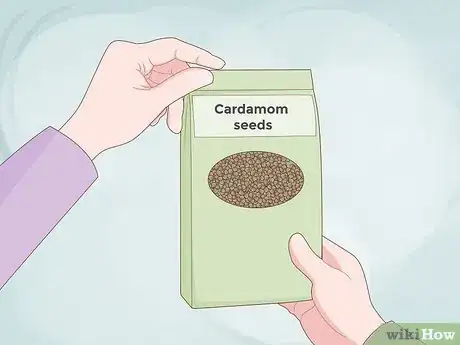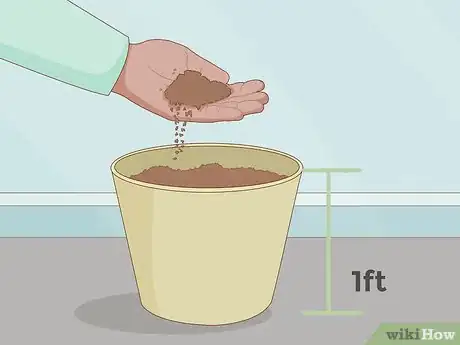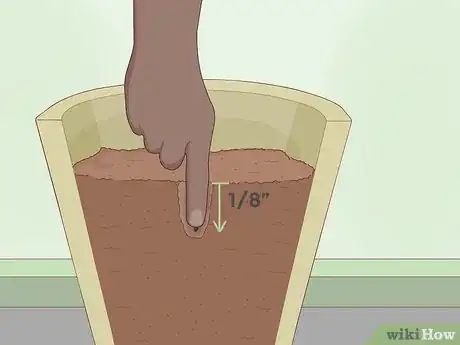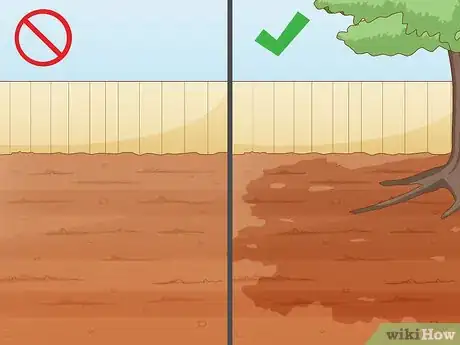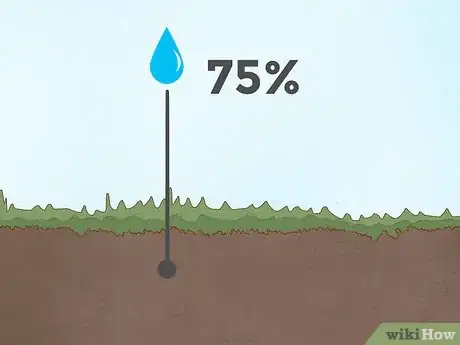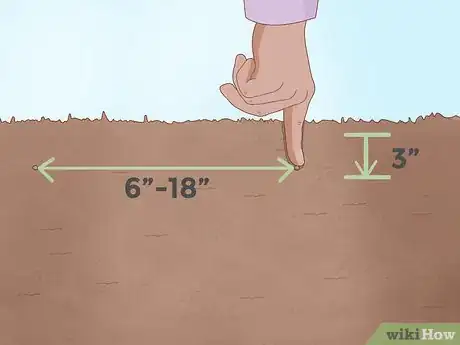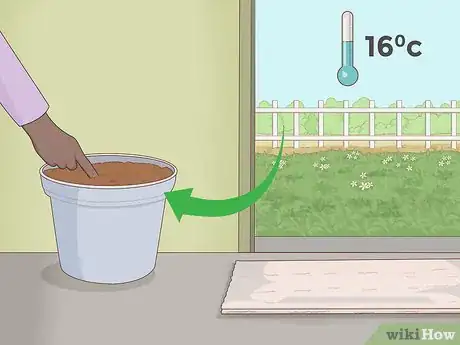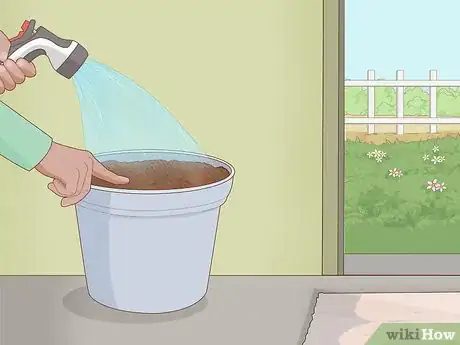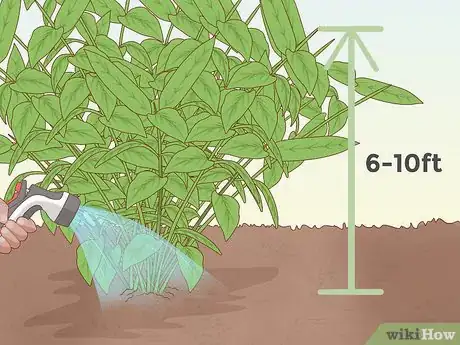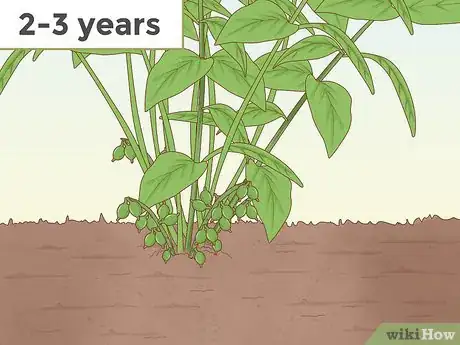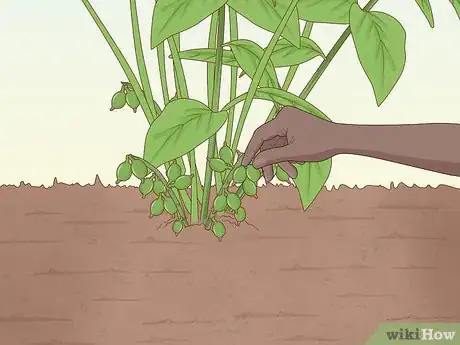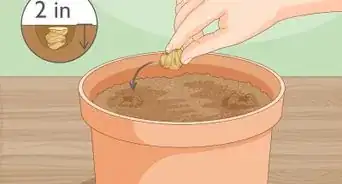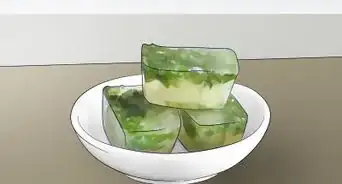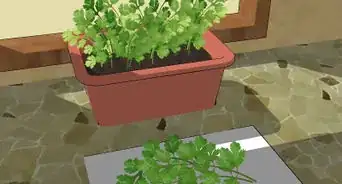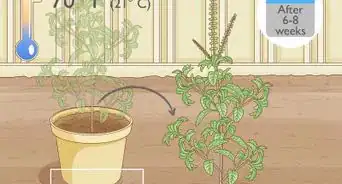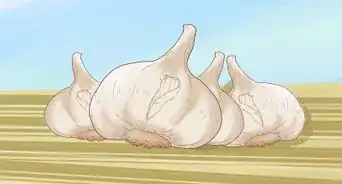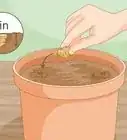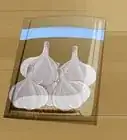This article was co-authored by Lauren Kurtz and by wikiHow staff writer, Jessica Gibson. Lauren Kurtz is a Naturalist and Horticultural Specialist. Lauren has worked for Aurora, Colorado managing the Water-Wise Garden at Aurora Municipal Center for the Water Conservation Department. She earned a BA in Environmental and Sustainability Studies from Western Michigan University in 2014.
wikiHow marks an article as reader-approved once it receives enough positive feedback. In this case, 100% of readers who voted found the article helpful, earning it our reader-approved status.
This article has been viewed 179,146 times.
Cardamom is one of the most expensive and unique spices in the world. If you live in a very warm, humid climate (or in US Department of Agriculture zones 10 to 12), you can grow your own cardamom plant. Plant a few cardamom seeds indoors and let them grow for a few months so they sprout above the soil. Transplant the seedlings to a shady place in your yard. It will take several years of watering and nurturing, but your plants will produce cardamom that you can harvest and use in baking or cooking.
Steps
Starting Seeds
-
1Get cardamom seeds from a grocery or agricultural supply store. Although you can collect cardamom seeds from capsules that you've purchased from the grocery store, it's best to buy cardamom seeds from an agricultural supply company. These seeds will be free from disease and are more likely to thrive.[1]
- Buy the seeds from local gardening supply stores or from online agricultural supply companies.
Tip: If you use seeds that you gather from a cardamom plant, get them from a plant that's at least 5 years old.
-
2Fill containers with loamy soil. The soil should be slightly sandy so it drains gradually. You can purchase loamy soil from most garden centers. If you're planning on transplanting the seedlings to your outside garden, you can use any size container. If you're going to leave the seeds in the container and grow the plants to maturity, use a pot that's at least 1 foot (0.30 m) deep and 6 inches (15 cm) wide.[2]Advertisement
-
3Plant the seeds 1⁄8 inch (0.32 cm) deep. Push a few of the seeds into the containers and cover each with 1⁄8 inch (0.32 cm) of soil. Water the seeds so the soil is completely moist.[3]
- Start as many cardamom seeds as you like, but plant them about 1 inch (2.5 cm) apart in the container so you can thin and transplant them once they start growing.
-
4Grow the cardamom until it sprouts a few leaves. The cardamom should germinate after about 30 to 45 days. This means you should see the cardamom plants begin to poke up through the soil. Continue to water so the soil stays moist and leave the seedlings in the container until you see at least 2 leaves on the seedlings.[4]
- It will take around 90 days for the seedlings to become large enough to transplant outside.
Transplanting and Caring for Cardamom
-
1Choose a space in the garden with well-draining soil. Pay attention to the soil after a heavy rain to see how it drains. You shouldn't see deep puddles remain, but the soil should stay moist. If the soil is too rich in clay, it will kill the cardamom plant, so find somewhere else in the garden or mix sand into the soil to break up the clay.[5]
- The ideal soil for cardamom is loamy with a pH level between 4.5 and 7.
-
2Pick a space with partial shade. Cardamom plants will die if they're in direct sunlight, so choose a planting area that has partial shade. If you only have a space that is completely shaded, it will work, but the plant may not grow as quickly.
- Cardamom plants usually grow under the canopy of trees that are above it.[6]
-
3Select a planting area that has high humidity. Since cardamom grows in subtropical forests, it needs high humidity to thrive in your garden. To plant the cardamom outside, the humidity needs to be around 75%.[7]
- Cardamom also prefers temperatures between 64 °F (18 °C) and 95 °F (35 °C).
-
4Plant the cardamom seedlings 1–1 1⁄2 in (2.5–3.8 cm) deep. Dig 1 in (2.5 cm) deep holes that are 6 to 18 inches (15 to 46 cm) apart. Place 1 seedling into each hole and surround the seedling roots with dirt. If you'd like to support the plants as they grow, drive a garden stake into the soil 2 inches (5.1 cm) away from the base of each plant.[8]
- As the cardamom grows, you can tie the plant to the stake.
- Avoid planting seeds too deep since they may not sprout if they don’t get adequate sun.
-
5Plant the cardamom in a container if you want to move it. If you live in a climate with temperatures that occasionally dip below 60 °F (16 °C), you may want to plant the seedlings in large pots instead of outside in the garden. This will allow you to bring the cardamom in when it gets cool.[9]
- If you use a pot, choose as large of a pot as you can for your space that's also easy to pick up so you can move it in and out of your house.
- If you do need to bring the cardamom inside your house, consider placing it in the warmest, most humid room of your house, such as the bathroom.
-
6Water the plants to keep the soil moist. Feel the soil with your fingers every day to ensure that the soil is most. Since the soil should never dry out, water until the soil is soaked.[10]
- The cardamom plants will need even more water during the summer when they're growing the fruit. Plan on watering more during these months.
-
7Add fertilizer twice a month during the growing season. Choose an organic fertilizer with high phosphorous content. Spread it in the soil around the cardamom plants 2 times a month during the summer growing season.[11]
- To add nutrients back to the soil, you'll also need to spread aged manure or compost once a year.
Tip: Heavy rain will wash away fertilizer, so wait to apply it until after a storm or heavy rain.
Harvesting Cardamom
-
1Grow the plants until they're 6 to 10 feet (1.8 to 3.0 m) high. Continue to water the plants regularly and fertilize them as needed. The plants will begin to grow tall, narrow stalks that reach high off of the ground.[12]
- Keep in mind that it will take a few years for the plants to put on a lot of growth.
- The stalks will grow rows of bright green leaves that are about 2 inches (5.1 cm) long.
-
2Wait 2 to 3 years to harvest the cardamom fruits. The plants will flower beginning in April or May and will continue to blossom through July or August. The yellow flowers are small and oval in shape.[13]
- The flowers hold capsules that contain 15 to 20 cardamom seeds.
- Some plants may take up to 4-5 years until they bloom.
- Although the plants flower early in the year, wait to begin harvesting until October or November, so the cardamom can ripen.
-
3Gather the cardamom capsules by hand. Once the capsules of cardamom fruit begin to dry out a little, pull one to see if it breaks easily. If the fruit snaps off easily, you can begin pulling off all of the ripe capsules.[14]
- Cardamom plants will continue to produce more cardamom seeds every year.
Did You Know? Cardamom is harvested 5 or 6 times throughout 1 harvest year. Wait 35 to 45 days in between each picking, so more of the cardamom can ripen.
-
4Dry the cardamom capsules. Depending on how many capsules you want to dry, you can use a variety of drying methods. For small-scale drying, spread the cardamom in a single layer and allow the sun to dry the capsules. Larger, commercial harvests often dry cardamom using extremely hot kilns.[15]
- Once the cardamom is dry, you can open the capsules and crush the cardamom to cook or bake with.
Community Q&A
-
QuestionHow long does it take to grow cardamom?
 Drew Hawkins1Community AnswerIt takes about 30-45 days to germinate cardamom seeds so they poke through the soil, and it takes about 90 days for the seedlings to grow large enough to be able to survive being transplanted outside. Once the cardamom is planted in the soil outside, it takes about 2-3 years before you can harvest their fruit, and some plants can even take up to 4-5 years.
Drew Hawkins1Community AnswerIt takes about 30-45 days to germinate cardamom seeds so they poke through the soil, and it takes about 90 days for the seedlings to grow large enough to be able to survive being transplanted outside. Once the cardamom is planted in the soil outside, it takes about 2-3 years before you can harvest their fruit, and some plants can even take up to 4-5 years. -
QuestionCan you grow cardamom in the US?
 Drew Hawkins1Community AnswerCardamom grows naturally on the hot and humid jungle floors of Southeast Asia, but they can be grown in the US if the climate is right. Cardamom grows well in the US Department of Agricultural zones 10 through 12, which includes the very bottom of Florida and the coasts of Southern California.
Drew Hawkins1Community AnswerCardamom grows naturally on the hot and humid jungle floors of Southeast Asia, but they can be grown in the US if the climate is right. Cardamom grows well in the US Department of Agricultural zones 10 through 12, which includes the very bottom of Florida and the coasts of Southern California. -
QuestionCan cardamom be grown in pots?
 Drew Hawkins1Community AnswerYes, you can grow cardamom in pots. If you live in an area with temperatures that can get below 60 °F (16 °C), you may want to plant the seedlings in large pots so you can bring them inside when it gets too cold. Choose as large of a pot as you can so the cardamom has plenty of space to grow.
Drew Hawkins1Community AnswerYes, you can grow cardamom in pots. If you live in an area with temperatures that can get below 60 °F (16 °C), you may want to plant the seedlings in large pots so you can bring them inside when it gets too cold. Choose as large of a pot as you can so the cardamom has plenty of space to grow.
Things You'll Need
- Small containers
- Cardamom seeds
- Soil
- Organic fertilizer
- Watering can
- Large pot, optional
References
- ↑ https://www.webindia123.com/garden/herb_spi/cardamom.htm
- ↑ https://balconygardenweb.com/how-to-grow-cardamom-growing-cardamom-elaichi/
- ↑ https://balconygardenweb.com/how-to-grow-cardamom-growing-cardamom-elaichi/
- ↑ https://youtu.be/QsPhcR2b1L0?t=385
- ↑ https://www.bhg.com/gardening/yard/soil/what-is-well-drained-soil/
- ↑ https://balconygardenweb.com/how-to-grow-cardamom-growing-cardamom-elaichi/
- ↑ https://balconygardenweb.com/how-to-grow-cardamom-growing-cardamom-elaichi/
- ↑ https://www.agrifarming.in/cardamom-farming/
- ↑ https://www.gardenista.com/posts/spice-kit-how-to-grow-ginger-turmeric-cardamom-at-home/
- ↑ https://balconygardenweb.com/how-to-grow-cardamom-growing-cardamom-elaichi/
- ↑ https://www.agrifarming.in/cardamom-farming/
- ↑ https://www.webindia123.com/garden/herb_spi/cardamom.htm
- ↑ https://www.webindia123.com/garden/herb_spi/cardamom.htm
- ↑ https://www.agrifarming.in/cardamom-farming/
- ↑ https://www.agrifarming.in/cardamom-farming/
About This Article
Cardamom is one of the most expensive spices in the world, but fortunately, you can grow your own if you live in a hot, humid climate. To get the seeds started, fill a 1-foot deep pot with loamy soil. Then, plant your seeds 1/8-inch deep and 1 inch apart. Keep the soil moist as they grow. When the sprouts grow leaves after about 90 days, you can transplant the seeds to the ground or move the pot outside. Choose somewhere with partial or full shade. If you’re transplanting the seedlings, plant them 1-inch-deep and 10 inches apart. Keep the soil moist and add an organic fertilizer twice a month during growing season. For more tips from our Gardening co-author, including how to harvest your cardamom, read on!
